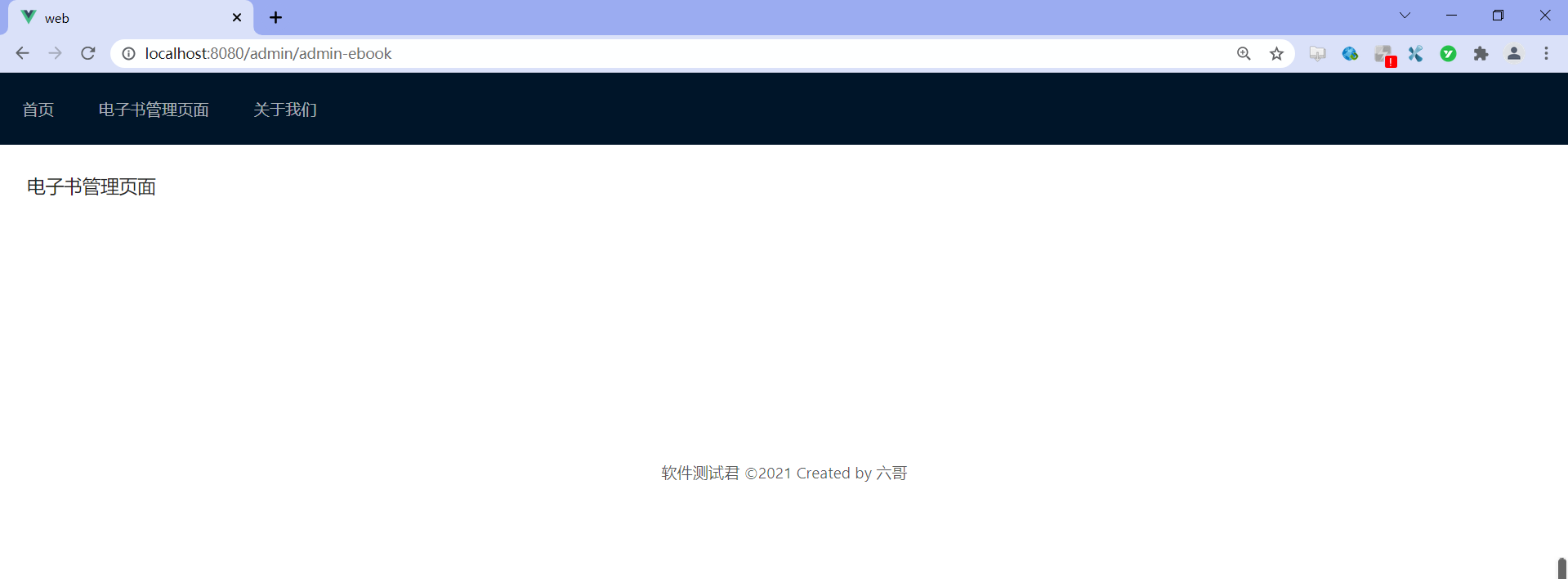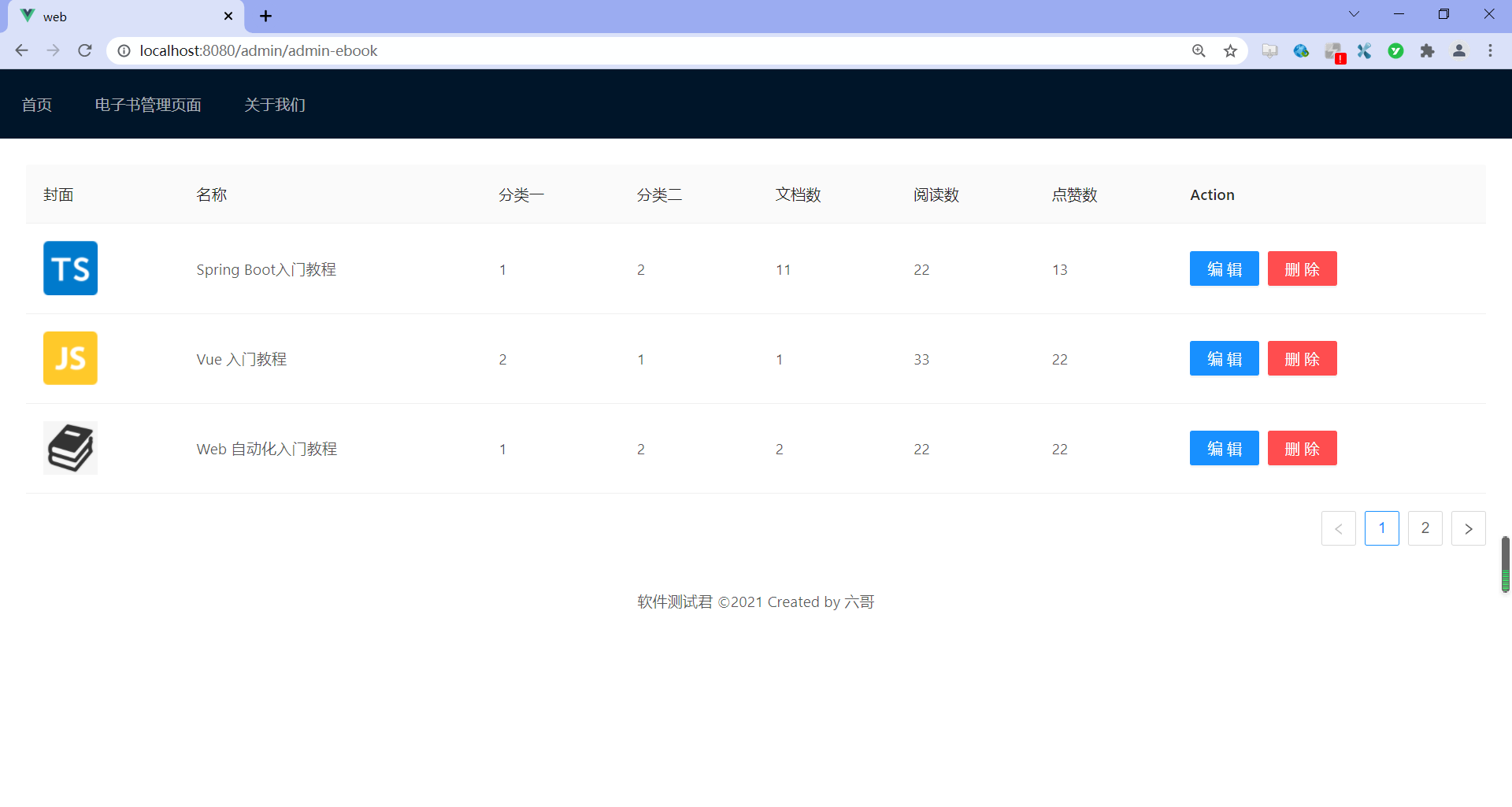|
一、Ant Design Vue在大量数据需要展示时,我们一般都会以报表的形式展现,按照直觉习惯,肯定使用table表格来展示行列数据。 因此,我们要使用Ant Design Vue组件库中的table组件,来进行数据的绑定。
1、官网地址官网地址:https://2x.antdv.com/components/table-cn#API
2、怎么使用我们先对电子书管理页面改造,将布局进行调整, 示例代码如下: <template> <a-layout class="layout"> <a-layout-content :style="{ background: '#fff', padding: '24px', minHeight: '280px' }"> <div class="about"> <h1>电子书管理页面</h1> </div> </a-layout-content> </a-layout> </template>效果如下: 
3、将电子书表格进行展示要做的事: - 表格渲染
slots: 自定义渲染title: 表头渲染customRender: 值渲染 示例代码如下: <template> <a-layout class="layout"> <a-layout-content :style="{ background: '#fff', padding: '24px', minHeight: '280px' }"> <a-table :columns="columns" :data-source="ebooks1" :pagination="pagination" :loading="loading" > <template #cover="{ text: cover }"> <img v-if="cover" :src="cover" alt="avatar"/> </template> <template #name="{ text: name }"> <a>{{ text }}</a> </template> <template #customTitle> <span> <smile-outlined/> Name </span> </template> <template #action="{ record }"> <span> <a-space size="small"> <a-button type="primary" @click="edit(record)"> 编辑 </a-button> <a-button type="danger"> 删除 </a-button> </a-space> </span> </template> </a-table> </a-layout-content> </a-layout></template><script lang="ts">import {SmileOutlined, DownOutlined} from '@ant-design/icons-vue';import {defineComponent, onMounted, reactive, ref, toRef} from 'vue';import axios from 'axios';export default defineComponent({ name: 'AdminEbook', setup() { const pagination = { onChange: (page: number) => { console.log(page); }, pageSize: 3, }; const loading = ref(false); const columns = [ { title: '封面', dataIndex: 'cover', slots: {customRender: 'cover'} }, { title: '名称', dataIndex: 'name' }, { title: '分类一', dataIndex: 'category1Id', key: 'category1Id', }, { title: '分类二', dataIndex: 'category2Id', key: 'category2Id', }, { title: '文档数', dataIndex: 'docCount' }, { title: '阅读数', dataIndex: 'viewCount' }, { title: '点赞数', dataIndex: 'voteCount' }, { title: 'Action', key: 'action', slots: {customRender: 'action'} } ]; //使用ref进行数据绑定 const ebooks = ref(); // 使用reactive进行数据绑定 const ebooks1 = reactive({books: []}) onMounted(() => { axios.get("/ebook/list?name=").then(response => { const data = response.data; ebooks.value = data.content; ebooks1.books = data.content; }) }) return { pagination, loading, columns, ebooks1: ebooks, ebooks2: toRef(ebooks1, "books") } }, components: { SmileOutlined, DownOutlined, },});</script><style scoped>img { width: 50px; height: 50px;}</style>实际效果: 
二、总结对于table组件的使用不是很熟的话,需要不断去尝试,简单说,就是对象属性的映射。 总体感觉下来,还是进行数据绑定后,在进行页面展示,如不是很清晰,请参考这篇《Vue3 列表界面数据展示详情》文章。 到此这篇关于Vue3 table表格组件的使用的文章就介绍到这了,更多相关Vue3 table表格组件内容请搜索51zixue.net以前的文章或继续浏览下面的相关文章希望大家以后多多支持51zixue.net!
下载地址:
Vue3 页面,菜单,路由的使用
一篇文章带你了解jQuery动画 |

